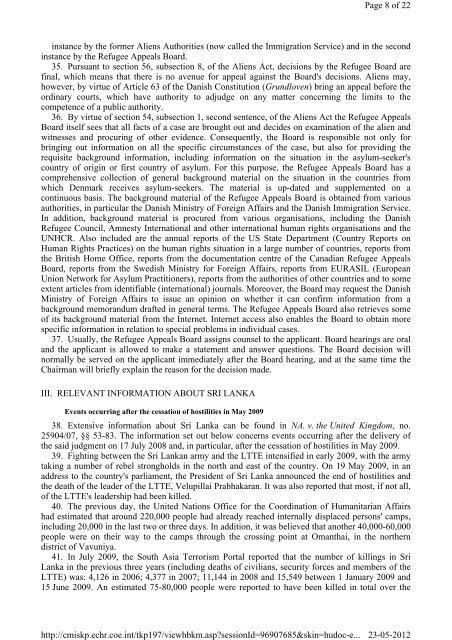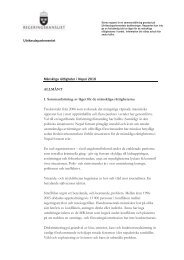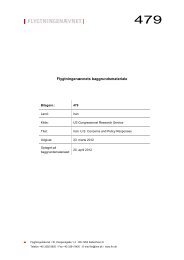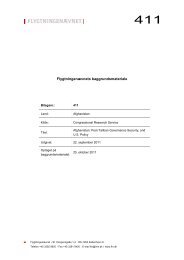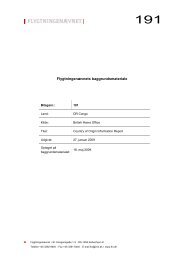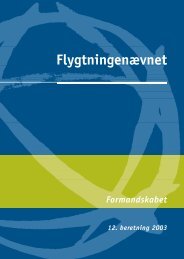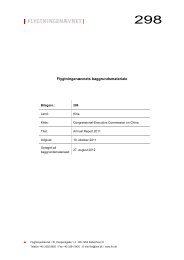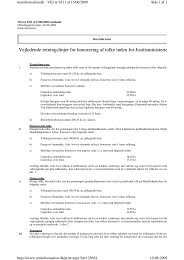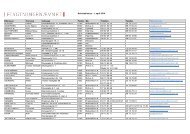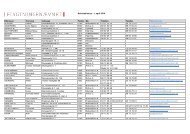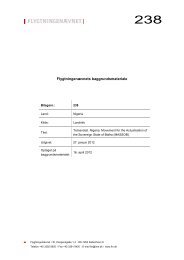FIFTH SECTION CASE OF S.S. AND OTHERS v ... - Flygtningenævnet
FIFTH SECTION CASE OF S.S. AND OTHERS v ... - Flygtningenævnet
FIFTH SECTION CASE OF S.S. AND OTHERS v ... - Flygtningenævnet
Create successful ePaper yourself
Turn your PDF publications into a flip-book with our unique Google optimized e-Paper software.
http://cmiskp.echr.coe.int/tkp197/viewhbkm.asp?sessionId=96907685&skin=hudoc-e...Page 8 of 2223-05-2012instance by the former Aliens Authorities (now called the Immigration Service) and in the secondinstance by the Refugee Appeals Board.35. Pursuant to section 56, subsection 8, of the Aliens Act, decisions by the Refugee Board arefinal, which means that there is no avenue for appeal against the Board's decisions. Aliens may,however, by virtue of Article 63 of the Danish Constitution (Grundloven) bring an appeal before theordinary courts, which have authority to adjudge on any matter concerning the limits to thecompetence of a public authority.36. By virtue of section 54, subsection 1, second sentence, of the Aliens Act the Refugee AppealsBoard itself sees that all facts of a case are brought out and decides on examination of the alien andwitnesses and procuring of other evidence. Consequently, the Board is responsible not only forbringing out information on all the specific circumstances of the case, but also for providing therequisite background information, including information on the situation in the asylum-seeker'scountry of origin or first country of asylum. For this purpose, the Refugee Appeals Board has acomprehensive collection of general background material on the situation in the countries fromwhich Denmark receives asylum-seekers. The material is up-dated and supplemented on acontinuous basis. The background material of the Refugee Appeals Board is obtained from variousauthorities, in particular the Danish Ministry of Foreign Affairs and the Danish Immigration Service.In addition, background material is procured from various organisations, including the DanishRefugee Council, Amnesty International and other international human rights organisations and theUNHCR. Also included are the annual reports of the US State Department (Country Reports onHuman Rights Practices) on the human rights situation in a large number of countries, reports fromthe British Home Office, reports from the documentation centre of the Canadian Refugee AppealsBoard, reports from the Swedish Ministry for Foreign Affairs, reports from EURASIL (EuropeanUnion Network for Asylum Practitioners), reports from the authorities of other countries and to someextent articles from identifiable (international) journals. Moreover, the Board may request the DanishMinistry of Foreign Affairs to issue an opinion on whether it can confirm information from abackground memorandum drafted in general terms. The Refugee Appeals Board also retrieves someof its background material from the Internet. Internet access also enables the Board to obtain morespecific information in relation to special problems in individual cases.37. Usually, the Refugee Appeals Board assigns counsel to the applicant. Board hearings are oraland the applicant is allowed to make a statement and answer questions. The Board decision willnormally be served on the applicant immediately after the Board hearing, and at the same time theChairman will briefly explain the reason for the decision made.III. RELEVANT INFORMATION ABOUT SRI LANKAEvents occurring after the cessation of hostilities in May 200938. Extensive information about Sri Lanka can be found in NA. v. the United Kingdom, no.25904/07, §§ 53-83. The information set out below concerns events occurring after the delivery ofthe said judgment on 17 July 2008 and, in particular, after the cessation of hostilities in May 2009.39. Fighting between the Sri Lankan army and the LTTE intensified in early 2009, with the armytaking a number of rebel strongholds in the north and east of the country. On 19 May 2009, in anaddress to the country's parliament, the President of Sri Lanka announced the end of hostilities andthe death of the leader of the LTTE, Velupillai Prabhakaran. It was also reported that most, if not all,of the LTTE's leadership had been killed.40. The previous day, the United Nations Office for the Coordination of Humanitarian Affairshad estimated that around 220,000 people had already reached internally displaced persons' camps,including 20,000 in the last two or three days. In addition, it was believed that another 40,000-60,000people were on their way to the camps through the crossing point at Omanthai, in the northerndistrict of Vavuniya.41. In July 2009, the South Asia Terrorism Portal reported that the number of killings in SriLanka in the previous three years (including deaths of civilians, security forces and members of theLTTE) was: 4,126 in 2006; 4,377 in 2007; 11,144 in 2008 and 15,549 between 1 January 2009 and15 June 2009. An estimated 75-80,000 people were reported to have been killed in total over the


